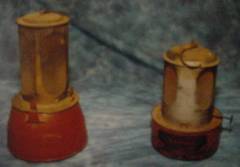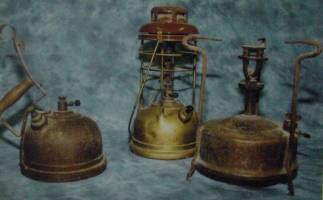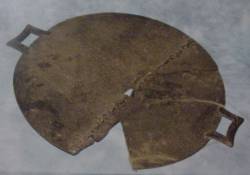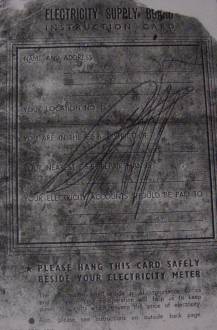
Oil Heaters and Lights
These are two paraffin oil heaters. They were usually used to keep young animals
warm. - These are two oil lanterns with glass globes and carrying handles.
Source: Richard Eyre and Jim Dalton.
Tilley Lamps
The Tilley Lamp (centre) gave good light from paraffin oil. The tank (bottom) was filled with oil and the pump (bottom right) was used to raise the pressure in the tank. This forced the oil up the centre pipe in a fine spray. A small knob (centre) controlled the flow. The spray of oil came out into a small cloth mantle at the top. The mantle had to be heated by burning methylated spirits under it for a couple of minutes. Then it was hot enough to burn the oil. There was a glass globe (missing on this one) to protect the mantle which was very fragile.
The tilley gave good light and made a buzzing sound.
The Storm Lamp (on the left) is another version of the Tilley. There was a
large reflector attached to the handle but this is missing from this one. The
lamp was useful. for checking animals at night. On the right is a cooking stove.
Source: Paddy Bergin.
Lantern
This Railway Lantern could be carried or hung on a carriage. The centre of
the railway lantern was turned around to give different coloured lights. The
colour of the lights were blue, red and white. There was a a replaceable glass
in the front of the lantern. The colours were changed by pushing a little trigger
on the back of the lantern and turning the handle at the top.
Source: Richard Eyre.
Culm
Culm was fuel made from coal dust, yellow clay and water. Geoff Brennan told us that the "culm" was brought from the Deer Park colliery near Castlecomer. It was usually brought by the colliery men, although sometimes the local people went to Castlecomer to bring it themselves. The road from Castlecomer is very hilly and the car men would sometimes have a "tracer" horse or mule to help the horse under the cart. The tracer was kept behind the cart going down hill to keep the cart from running away. It was moved to the front going up hill to help the first horse.
Sometimes the car men might have a couple of drinks on the way home and might fall asleep in the car. This was no problem because the horse always knew his way home.
Tony Coady told us that the yellow clay was usually dug in spring. Any place where there were rushes would be good for yellow clay. It was kept covered for a couple of months until it dried into a cake. It was broken up with a mallet and mixed with water and culm, just like mixing cement. There were about 14 buckets of culm to 1 bucket of yellow clay.
Up to 5 tons of culm could be mixed together. Sometimes two horses were used to help mix it. They were walked around in circles to tread on the culm and mix it with their hooves. It was tiring work because the culm was sticky. Geoff Brennan told us that some horses got cute and kept walking in their own footprints. When the culm was mixed it was made into "bums" with an implement that was called a "bummer".
If the amount of culm was small, it was sometimes mixed by people walking on it or by shovels. The "bums" could be made by hand. The bums were then dried out and used for winter fuel. They looked like coal nuggets.
"Bummer"
The proper word for this was "bomber" but nobody would call it or know what
you were talking about if you said "bomber" because the "bums" or "bombs" it
made, looked like grenades or bombs. Bums were made out of culm. First you would
have a slab of culm, and you would press the two cylinders at the end of the
bummer through the culm, and by taking it out again and then releasing the handle,
you would have two cylinder-shaped "bums". They were used as coal is used today.
Source: Tony Coady.
Griddle
This is a griddle for making griddle bread. The bread was made over an open
fire. Part of this one is missing.
Source: Tony Coady.
Electricity
Many of the old people we talked to said that the thing which really changed the old way of life was the coming of electricity. In the 1950s the Electricity Supply Board brought electricity to this area for the first time.
Candles, oil lamps and wireless sets all began to disappear and "rambling" died out.
"It brought the end of the ghosts too." Geoff Brennan told us.
This letter and instruction card was sent to each family getting electricity to explain to them how to read their meter and pay their bills.
This one belonged to Michael Doheny, Coolcashin, Gathabawn.
Source: Veronica Doheny.